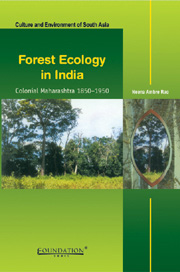Book contents
- Frontmatter
- Contents
- Preface
- Glossary
- Maps
- 1 Introduction
- 2 Pre-Colonial Maharashtra
- 3 Early British Management of Forests
- 4 Evolution of Forest Policy and Forest Acts of 1865 and 1878
- 5 Implementation of 1878 Act
- 6 Forest Policy During 1900–1950
- 7 People's Resistance
- 8 Conclusion
- Appendix - I
- Appendix - II
- Bibliography
- Index
3 - Early British Management of Forests
Published online by Cambridge University Press: 26 October 2011
- Frontmatter
- Contents
- Preface
- Glossary
- Maps
- 1 Introduction
- 2 Pre-Colonial Maharashtra
- 3 Early British Management of Forests
- 4 Evolution of Forest Policy and Forest Acts of 1865 and 1878
- 5 Implementation of 1878 Act
- 6 Forest Policy During 1900–1950
- 7 People's Resistance
- 8 Conclusion
- Appendix - I
- Appendix - II
- Bibliography
- Index
Summary
The areas along the coastal belt and Western Ghats in Bombay Presidency were once thickly forested with abundant greenery. So much so that Captain Dickenson of the East India Company stated. “The whole country (coastal region) was lying waste and unpopulated. That upto about 1850, wasteland was everywhere so abundant as to create a feeling of despair as to the future of the district, that the increase of cultivation was so much desired that the poorest people were allowed to cut down as many trees as they liked merely for the purpose of clearing the land and that wood itself was abundant, that everyone cut where and as they liked.”
Likewise, available records indicate that the teak forests allured the British officers of the East India Company, when they arrived at Bankot, in Ratnagiri district in 1798. The teakwood found in this region was of a harder grain. Being equal in size with the Malabar timber, it was highly valued of the two because of its reputed durability. The curved teak logs, known as Bankot knees, were largely exported to Mumbai. Stout ribs and frameworks of the old Indian Navy also came from Bankot.
There is hardly any evidence of conflict between agriculture and forests during the pre-British times, as land was more than adequate for a sparse population. In fact, even after 20 years of British East India Company rule, descriptions of rich teak forests are found in Bombay Presidency.
- Type
- Chapter
- Information
- Forest Ecology in IndiaColonial Maharashtra, 1850-1950, pp. 40 - 63Publisher: Foundation BooksPrint publication year: 2007



